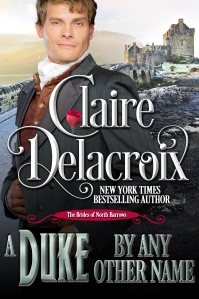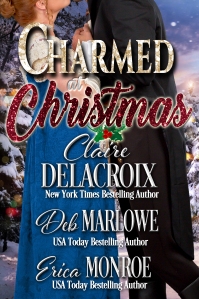I’m starting off a series of posts from the authors of the Regency romance novellas in the Christmas at Castle Keyvnor collection. We’ll each talk a little bit about our research and our story.
As most of you know, I don’t usually write stories set in the Regency period, although it is an era that fascinates me. I read a lot of Regency romance written by contemporary authors, but what is particularly fun about the Regency era is how much fiction was published within that period. Reading the same stories that my characters might have read is consistently a favorite research avenue of mine. Technically, the Regency era is from 1811 to 1820, but Wiki notes that the period is often entended to 1795 to 1837. I like the broader parameter for finding books.
Let’s look today at a few authors and books from that period.
 The most obvious author to read, of course, is Jane Austen, particularly if you’re interested in social conventions and romance. Her books – Sense and Sensibility (1811), Pride and Prejudice (1813), Mansfield Park (1814), Emma (1815), Northanger Abbey (1818) and Persuasion (1818) – are must-reads for all Regency romance fans. I really enjoy her wit and it’s hard to pick a favorite. If pressed, I have to say P&P, because I like how Elizabeth challenges Mr. Darcy’s expectations, prompting him to take a second look. On the other side of the coin, his criticism provokes Elizabeth to reconsider her own actions. They change each other, and I like that.
The most obvious author to read, of course, is Jane Austen, particularly if you’re interested in social conventions and romance. Her books – Sense and Sensibility (1811), Pride and Prejudice (1813), Mansfield Park (1814), Emma (1815), Northanger Abbey (1818) and Persuasion (1818) – are must-reads for all Regency romance fans. I really enjoy her wit and it’s hard to pick a favorite. If pressed, I have to say P&P, because I like how Elizabeth challenges Mr. Darcy’s expectations, prompting him to take a second look. On the other side of the coin, his criticism provokes Elizabeth to reconsider her own actions. They change each other, and I like that.
Within Austen’s books, however, there are references to other authors who were her contemporaries (or close to it) whose works were popular with young women. In Emma, Harriet Smith is disappointed that her beau, Mr. Martin, forgets to read the book she has recommended to him – The Romance of the Forest, which is by Ann Radcliffe. In Northanger Abbey, the protagonist Catherine Morland loves Gothic novels, particularly Mysteries of Udolpho, also by Ann Radcliffe.
According to Wiki, Ann Radcliffe was a “pioneer of the Gothic novel”. Her works certainly were popular in her time and she was comparatively well paid for her work. The Romance of the Forest (1791), The Mysteries of Udolpho (1794), The Italian (1797) are several of her books that I’ve read. They have a lot of description of the landscape and the pacing is slow. They are long books and the heroines weep a lot. (They are not very active protagonists.) It’s easy to see how people found Radcliffe’s depiction of supernatural elements to be compelling (although I am skeptical that Mr. Martin read Forest so very quickly once he did get a copy!)
I haven’t read Catherine Cuthbertson, although she is said to be an author who was influenced by Radcliffe. Her works include Romance of the Pyrenees (1803), Forest of Montalbano (1810), and The Hut and the Castle: a Romance (1823).
Sir Walter Scott’s fiction is also considered to be Regency era literature and much of it is romantic in tone. The Lady of the Lake (1810), The Bride of Lammermoor (1819) and Ivanhoe (1820) would be good choices for their glimpse of Regency-era romance. I also use Scott’s Minstrelsy of the Scottish Border (1802-3), in which he recorded oral stories of Scotland, as a reference when I write Scottish romances.
Lord Byron was a romantic poet, but also an influence over romantic fiction both during his life and after his death. His excesses, moodiness, periodic charm, good looks and tragic ending have been captivating to many – even now, we talk of Byronic heroes – and that his only daughter, Ada, was so clever has inspired many a ‘bluestocking’ Regency heroine. Of his own work, the narrative poem Childe Harold’s Pilgrimage (1812-1818) is probably the best known.
 One Regency-era author often forgotten or overlooked is Mary Shelley, whose work Frankenstein (1818) was published in the period. Her husband Percy Boyd Shelley was one of the romantic poets as well as a friend of Byron’s. I love that this story resulted from a challenge between writers: Mary, her future husband Percy, Lord Byron and John Polidori competed to discover who among them could write the best horror story. Mary’s idea of a doctor creating a living creature then being horrified by the result has become a cornerstone of the horror genre. It remains a great read and a classic book. Polidori’s story, btw, was The Vampyre (1819). I still need to read that one.
One Regency-era author often forgotten or overlooked is Mary Shelley, whose work Frankenstein (1818) was published in the period. Her husband Percy Boyd Shelley was one of the romantic poets as well as a friend of Byron’s. I love that this story resulted from a challenge between writers: Mary, her future husband Percy, Lord Byron and John Polidori competed to discover who among them could write the best horror story. Mary’s idea of a doctor creating a living creature then being horrified by the result has become a cornerstone of the horror genre. It remains a great read and a classic book. Polidori’s story, btw, was The Vampyre (1819). I still need to read that one.
There are also stories written after the Regency which portray the era. One of the things I always notice about Regency characters is their obsession with appearances and their frank discussions about money. Mr. Darcy is interesting at dances and social events because of his annual income, which the various ambitious mamas seem to know down to the shilling. As a result, I’ve always enjoyed William Thackeray’s Vanity Fair, which takes a dim view of this obsession with the physical realm, and his cunning heroine Becky Sharp. It was published in 1848 and is often considered the first Victorian novel, partly because Becky isn’t very sympathetic, partly because of its social criticism. It gives good insight into what people were prepared to do to maintain those appearances, though.
The Brontë sisters were published later than the Regency era, although their work is romantic and I think it contributed a great deal to the romance genre and reader expectations. Jane Eyre (1847) by Charlotte Brontë has definite commonalities with Ann Radcliffe’s work, given that the heroine is left with nothing and needs to conquer obstacles to win love and her happy ending. Wuthering Heights (1847) by Emily Brontë is another Gothic classic, albeit with a more tragic twist, while Anne Brontë’s The Tenant of Wildfell Hall (1848) has been called the first feminist novel.
Oscar Wilde’s work was published well after the Regency, but I love his wit. His dialogue is just wonderful and his social commentary is cutting. Lady Windemere’s Fan (1892), An Ideal Husband (1895) and, of course, The Importance of Being Earnest (1895) are wonderful and inspiring reads for all writers.
Another great favourite of mine when it comes to Regency romance is Georgette Heyer. Her sparkling dialogue, wit and sense of humor are unrivalled in the genre. One of her books that I revisit over and over again is The Grand Sophy (1950) with its practical, problem-solving heroine, squaring off with a hero who has learned to worry only about himself.
 I found my inspiration for A Duke by Any Other Name in a work of fiction that depicts an era a little earlier than the Regency—I love Baroness Orczy’s Scarlet Pimpernel (1903). I love a hero in disguise, and particularly enjoy that this Sir Percy is consistently dismissed as a fop and a fool, even as he is orchestrating the escape of aristrocrats from Paris and cheating Lady Guillotine. In my story, Alexander, Duke of Inverfyre, is hunting a jewel thief, one who has ruined his sister’s reputation. He does so in disguise, but Daphne isn’t fooled—and Alexander is tempted. Will Daphne’s curiosity win the duke? Or will she jeopardize his quest, right before it is fulfilled? I had a lot of fun with this story and hope you enjoy it, too.
I found my inspiration for A Duke by Any Other Name in a work of fiction that depicts an era a little earlier than the Regency—I love Baroness Orczy’s Scarlet Pimpernel (1903). I love a hero in disguise, and particularly enjoy that this Sir Percy is consistently dismissed as a fop and a fool, even as he is orchestrating the escape of aristrocrats from Paris and cheating Lady Guillotine. In my story, Alexander, Duke of Inverfyre, is hunting a jewel thief, one who has ruined his sister’s reputation. He does so in disguise, but Daphne isn’t fooled—and Alexander is tempted. Will Daphne’s curiosity win the duke? Or will she jeopardize his quest, right before it is fulfilled? I had a lot of fun with this story and hope you enjoy it, too.
A Duke by Any Other Name is included in the anthology Charmed at Christmas and will be available in a solo digital edition (with the cover at left) in March 2018.
Claire Delacroix’s A Duke by Any Other Name
Daphne Goodenham has always been determined to wed a duke—not just because she loves fine dresses and parties, but because she wants to guarantee that she and her sister are never destitute again. When she meets the Duke of Inverfyre, a notorious fop, she immediately notices intriguing inconsistencies. Is there more to the duke than meets the eye? Why would he hide the truth if he were handsome, young, rich and a duke? Alexander, the Duke of Inverfyre, is bent on catching a notorious thief who injured his sister, no matter what the cost. But when the lovely Miss Goodenham is bent on charming him, Alexander’s disguise proves to be no defense against her curiosity—and he has no resistance to her kiss. Will Daphne inadvertently foil Alexander’s plan? Will he have to sacrifice her interest to avenge his sister? Or can Daphne ensure Alexander’s triumph and make her own Christmas wish come true?
Available September 26, 2017
Pre-order now at:











